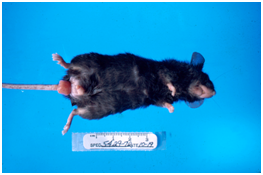Etiology: Citrobacter rodentium is a Gram-negative, non-motile rod implicated as a cause of transmissible murine colonic hyperplasia in young mice.
Incidence: The incidence of infection with Citrobacter rodentium is rare.
Transmission: Citrobacter rodentium is transmitted through the fecal-oral route. Suckling and recently weaned pups are more susceptible than adults, with higher mortality in some inbred strains (C3H/HeJ, C57BL/6, DBA/2J and NIH Swiss) as compared to others.

Clinical Signs: This disease is usually transient in mice, lasting only about 4 weeks. Affected mice look sick and may excrete soft feces. Mortality is variable. Survivors may have rectal prolapses (see photo, right). Adults show no clinical signs of illness.
Pathology: The colon, especially the descending portion, and occasionally the cecum, have a greatly thickened mucosa, increasing the relative size of the large bowel (A.). Bacterial colonization of the bowel for 10 days results in maximum mucosal hyperplasia at around day 16 post-infection. The crypts of the colon are greatly elongated with active cellular mitoses at the base of the crypts and little inflammatory reaction (B.). When stained with silver or Gram stains, the bacteria may be seen attached to the surface epithelium. The mucosal lesions resolve by day 45 post infection.

Features of this disease that differ from those of pathogenic Helicobacter infection include the following:
1) Hyperplastic lesions occur principally in descending colon.
2) There is minimal inflammatory cell infiltrate of mucosa unless mucosal erosions occur.
3) Mortality is common in young mice, and colonic lesions occur in mice of all ages.
Diagnosis: PCR of feces is a sensitive method for detection of Citrobacter infections. Culture of feces can be performed but may be unrewarding since bacterial colonization is transient and proliferative colonic lesions persist beyond the period of colonization. Isolation and biotyping of C. rodentium is important since nonpathogenic but related Citrobacter sp. can be found in mouse intestine.